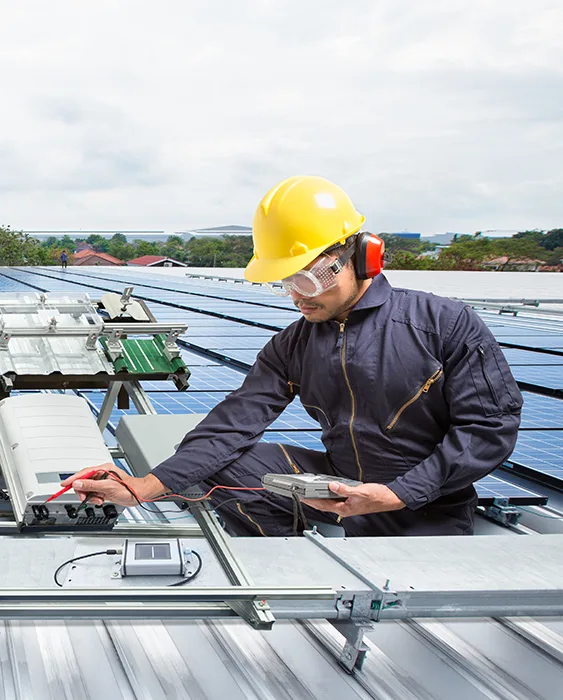Demand response explained
What is demand response and why does it matter to your business?

Picture this: There’s a heatwave, and AC units everywhere are working overtime to keep indoor temperatures from going through the roof. The problem is that this uses a lot more power than usual, which means energy demand is spiking. The region’s grid is nearing capacity, and there’s a risk of widespread blackouts or brownouts if the situation is left to run its course.
That’s when the grid equivalent of the “Bat-Signal” goes out. An alarm sounds at a steel plant in New Jersey and workers temporarily put production on hold. Data centers in Texas flick the switch, immediately shutting off their warehouses full of power-hungry computers. Demand for power drops, the grid rebalances itself and blackouts are much less likely to occur. Before you know it, those businesses that dropped what they were doing are back up and running again like nothing happened.
That’s demand response in action (minus the “Bat-Signal”, of course). So, how does it work and why is it a vital tool in maintaining a reliable electricity supply in even the most extreme circumstances?
What is demand response?
At its most basic, demand response is a system where electricity customers reduce their consumption as and when needed by the grid.
As we consume more power, we have fewer reserves. And, when reserves become scarce, not only does the price move up but the risk of blackouts or brownouts increases. When this happens, businesses that participate in demand response will drastically reduce their consumption for a short time. This can be anywhere from milliseconds to 30 minutes — however long it takes to rebalance supply from the grid with demand from users.
Typically, it’s large industrial businesses like steel mills, bitcoin miners or food production plants that consume huge loads of electricity and participate in demand response. This is because they have the flexibility to give significant capacity back to the grid at short notice (unlike hospitals or fire stations that need a steady, reliable supply). They can shut down so fast that they’re hugely helpful in restoring balance and enhancing grid reliability.
Things get more complicated when you realize that demand response comes in many shapes and sizes — and that various regions and ISOs have different approaches to it. For instance, some customers will be paid to offer greater flexibility by shutting down high-consumption operations where necessary. Others, involved in passive demand response, won’t receive payment for their participation but will likely enjoy lower prices on the power they use. This complexity is why we have a team of experts working behind the scenes to help customers manage their demand response programs.
How does it work?
Demand response is commonly deployed at times of extreme scarcity driven by factors like the weather — with winter storms and heatwaves being major culprits. However, this isn’t always the case. Demand response also covers times when conventional power plants are in short supply due to temporary outages and when there are fluctuations in the supply generated by solar and wind.
At any of these times, if the imbalance between demand and supply hits a certain point, demand response participants receive a signal from their grid operator instructing them to curtail their consumption. How this gets activated within each business is different, depending on their operational infrastructure. It can be as basic as a big red button pressed to set off an on-site alarm that begins a manual shutdown. In many cases, though, it’s a lot more sophisticated and an automated signal goes out in the facility and triggers a shutdown within milliseconds.
No matter how it gets activated internally at a facility, demand response is a powerful tool to balance the grid because a decrease in consumption at the right time is just as helpful as an increase in production at the right time. It’s why demand response is viewed as an “alternative power plant” due to its ability to give supply back to the grid.
What does it mean for businesses?
You may be wondering why any large-scale business would voluntarily shut down operations even for half an hour? For most, it’s because they get paid for that flexibility — and, in some cases, build that arrangement into their business plans.
Beyond that payment, however, demand response provides businesses with the opportunity to be smarter in how they use electricity. As mentioned above, when demand rises, the price of energy increases. Many businesses have their demand response protocols kick in as soon as wholesale electricity hits a certain price — turning to on-site generation or storage facilities to supply them instead.
Demand response can also help businesses focus their grid consumption on times when electricity generation from renewable sources is high (i.e., when the sun is shining, or the wind is blowing). This can be more sustainable, while helping them to use power when the cost is at its lowest.
If a business is strategic – and able to shift their demand to times when wind generation is high – the price of power can actually be consumed at negative prices. So, not only do they get paid to consume electricity when this happens, but they get paid again to provide a reserve.
How can Shell Energy support you?
Demand response is an attractive opportunity for many businesses, giving them the ability to reduce their costs and improve their sustainability. We at Shell Energy can help your business manage that process as well as supply your energy.
Acting as an agent between your business and the grid, we can help you monitor consumption and manage your response to signals from your local grid operator. Our goal is to make it as simple as possible for you to make the best possible use of your business’ electricity demand.